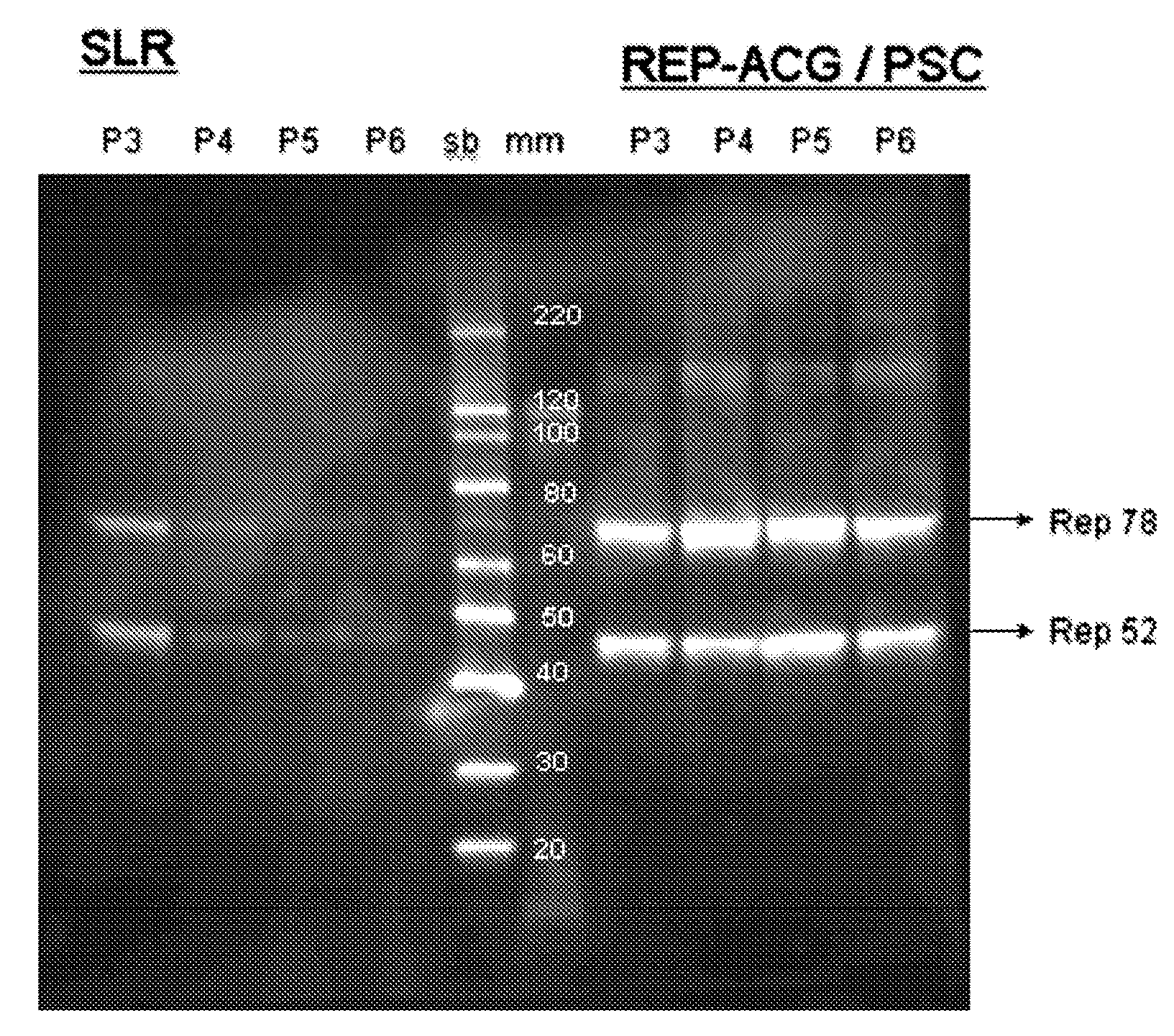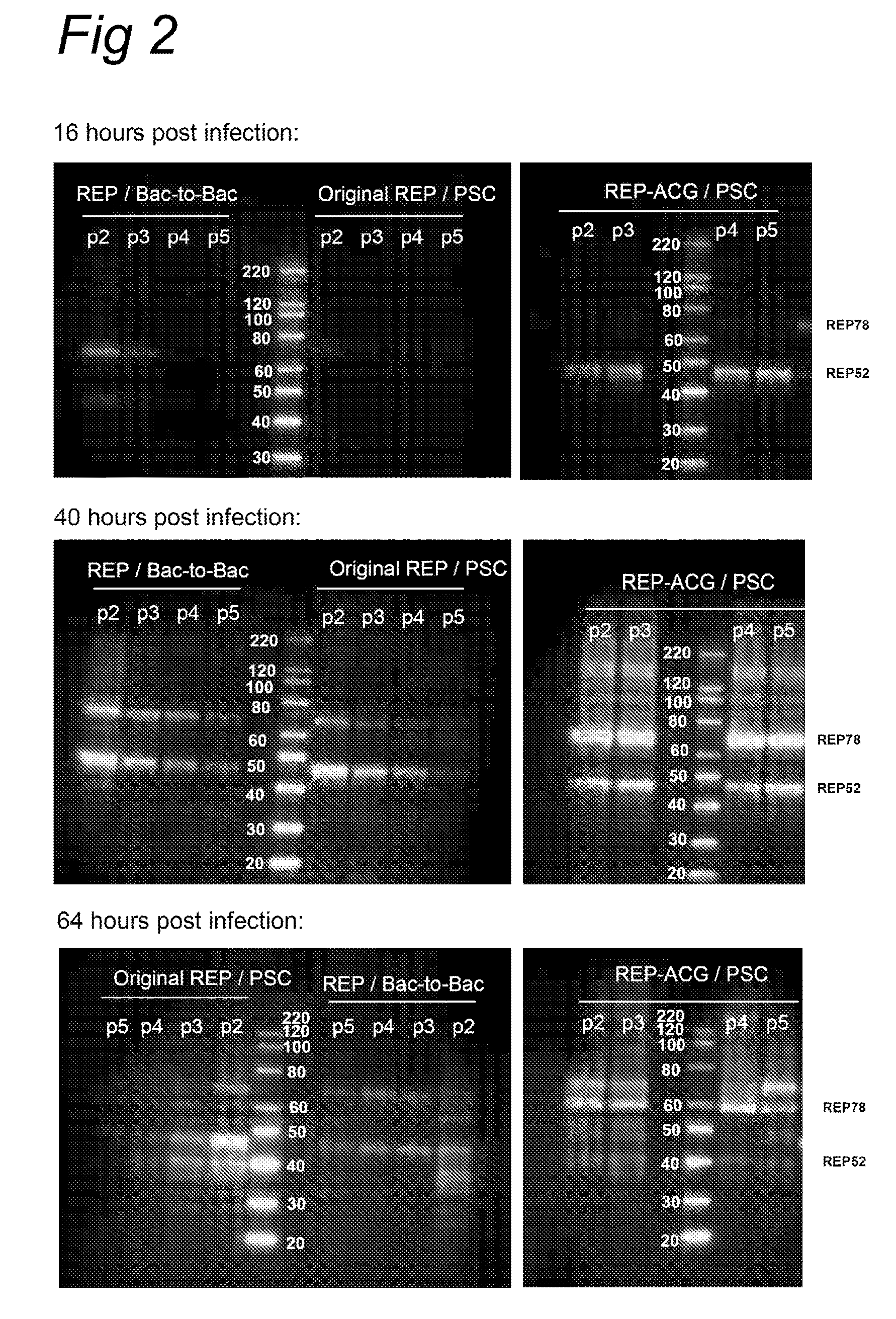Vectors with modified initiation codon for the translation of aav-rep78 useful for production of aav
a technology of aav and aav-rep78, which is applied in the direction of viruses/bacteriophages, dsdna viruses, peptide sources, etc., can solve the problems of baculovirus construct for expression of the two rep protein, as used, and the inability to produce commercially viable vectors for clinical us
- Summary
- Abstract
- Description
- Claims
- Application Information
AI Technical Summary
Benefits of technology
Problems solved by technology
Method used
Image
Examples
example 1
Rep Constructs
1.1. Materials & Methods
1.1.1 Baculovirus Plasmid Construction
[0059]In order to express Rep78 and Rep52 from a sole bicistronic messenger RNA, the ATG initiation codon of Rep78 situated on the expression vector pFastBacDualSLR (Urabe et al., 2002, supra) was converted to ACG. The upstream primer used was:
BamHI5′-cgcggatcctgttaagACGGCGGGGTTTTACGAGATTGTGATTAAGGTC-3′(SEQ ID NO.8)PRIMER SEQUENCE forward
[0060]The 3′-primer that was used in the PCR reaction was flanking the REP78 gene and contains a XbaI site (TCTAGA):
XbaI5′-AGGCTCTAGATTCGAAAGCGGCCCG-3′(SEQ ID NO.9)PRIMER SEQUENCE reverse
[0061]The sequence between the above-mentioned primer set was amplified by PCR (reaction volume 50 μl; 1×Pfx Amp. Buffer, 0.3 mM dNTP's, 1 mM MgSO4, 150 mM primer forw., 150 mM primer rev., 2× enhancer solution, template 50 ng (pFastBacDualSLR), 1 U Platinum Pfx (Invitrogen, Carlsbad, Calif., USA) using the following protocol: 1 cycle of 95° C., 5 min; 35 cycles of 95° C., 15 se...
example 2
Cap Constructs
2.1.1 Baculovirus Plasmid Construction
[0065]In order to express VP1,2,3 from a sole polycistronic messenger RNA, the baculovirus-AAV-Cap construct was designed as described by (Urabe et al., 2002, supra). Briefly, the ATG initiation codon of VP1 was mutated to ACG. A potential ATG initiation codon at position 11 has been changed to ACG. The splice acceptor site downstream of the VP1 initiation codon was destroyed (mutation at position 21 and 24). The mutated Cap expression cassette was cloned into a baculovirus expression construct; pFastBacDual (pFBDAAV1VPm11) with BamH1 / StuI restriction sites. This plasmid (pFBDAAV1VPm11) was the starting material for introduction of alternate initiation codons for VP1. The forward primer used by Urabe et al. (2002, supra) in order to introduce the mentioned mutations was:
BamHI 1 11 21 245′-cgcggatcctgttaagACGGCTGCCGACGGTTATCTACCCGATTGGCTC-3′(SEQ ID NO. 1)
The following forward primers were used to make the...
example 3
Stability of rAAV Constructs with Modified Rep 78 Initiation Codon in Insect Cells
[0076]3.1 Comparison of the Stabilities of Various rAAV Constructs in Insect Cells
[0077]rAAV productions in SF+ cells were performed as described above in Example 1. For all productions the ITR containing baculovirus and the capsid gene containing baculovirus were identical, the passage number was the same as the Rep gene containing baculoviruses. 4 different Rep gene containing baculoviruses were used: 1) The REP-ACG / PSC, 2) SLR: the original construct by Urabe et al. (2002, supra), 3) Rep52+Rep78(B2B): Two separate Bac-to-Bac baculoviruses, one containing the Rep 78 gene and the other one containing the Rep 52 gene. 4) Rep52+Rep78(PSC): Two separate protein sciences baculoviruses one containing the Rep 78 gene and the other one containing the Rep 52 gene.
[0078]Results are shown in FIG. 4. At fifth baculovirus passage rAAV production is already improved by more than a factor 10 using a REP-ACG / PSC in ...
PUM
| Property | Measurement | Unit |
|---|---|---|
| ionic strength | aaaaa | aaaaa |
| temperature | aaaaa | aaaaa |
| ionic strength | aaaaa | aaaaa |
Abstract
Description
Claims
Application Information
 Login to View More
Login to View More - R&D
- Intellectual Property
- Life Sciences
- Materials
- Tech Scout
- Unparalleled Data Quality
- Higher Quality Content
- 60% Fewer Hallucinations
Browse by: Latest US Patents, China's latest patents, Technical Efficacy Thesaurus, Application Domain, Technology Topic, Popular Technical Reports.
© 2025 PatSnap. All rights reserved.Legal|Privacy policy|Modern Slavery Act Transparency Statement|Sitemap|About US| Contact US: help@patsnap.com



